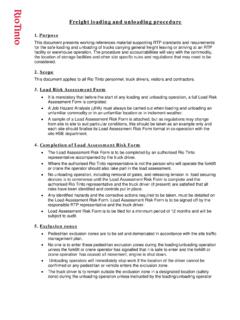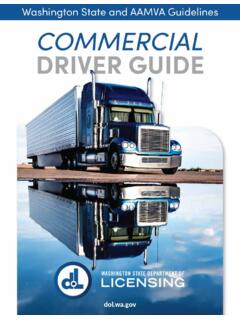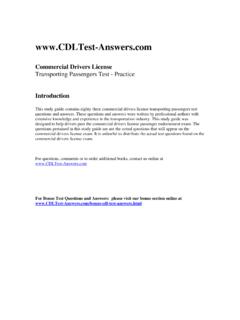Transcription of Carrying passengers on farm trailers AIS36
1 1 of 3 pagesHealth and Safety ExecutiveHealth and Safety ExecutiveAgriculture Information Sheet No 36(rev1)HSE information sheetCarrying passengers on farm trailersIntroduction This information sheet is aimed at anyone who uses a trailer to move people around on a farm. It provides advice on the features a trailer should have if it is used to carry passengers . It only considers on-farm use (ie away from the public highway). Travelling on the public highway with passengers on a trailer may be an offence under road traffic legislation and you should consult the police on what further precautions (if any) you should take. Remember that parts of the road traffic law apply to any area where there is public access (eg farm driveways with a public footpath). Towing vehicle The tractor or other towing vehicle: must be suitable for the purpose, and maintained in good working order, particularly the steering, brakes (both parking and service), mirrors and tyres; should have the facility to operate trailer brakes, preferably directly from the service brakes, but where this is not possible, from the hydraulic services; should be correctly and securely coupled to the trailer being used.
2 In particular, the hitch of the tractor should be compatible with the trailer drawbar connection (eg hook and eye, clevis to drawbar) and all necessary securing pins should be in place; and should be provided with a roll-over protective structure (ROPS) where there is a risk of injury in an overturn, eg a tractor fitted with an approved safety cab or frame. The driver of the towing vehicle should be a mature, competent, and responsible person. Adequate training should have taken place to ensure their competence and take care to make sure the driver is mature enough, particularly if they are under 18. Remember that young people may need greater instruction, training and supervision. Trailer The trailer should be in sound condition and maintained in good working order, including in particular the tyres and brakes, the floor and sides of the trailer and the connection to the tractor (eg pick-up ring or drawbar).
3 It should not be possible for the driver or a passenger to come into contact with the wheels (or tracks) from any position they may be riding in (ie on either the towing or towed vehicle). 2 of 3 pagesHealth and Safety ExecutiveBrakes (either hydraulic or air) should be fitted on at least one axle of the trailer. They should be connected directly to the tractor s service brakes. If this is not possible, they should be readily operated from the normal driving position (eg the tractor seat). Fit tail-lighting systems (including direction indicators) in full working order, to both the towing and trailed vehicles. (These are the vehicle s normal road-going lights.) When passengers are to be carried after dark, provide effective lights that will illuminate the access/egress areas and the area of the trailer used by passengers .
4 (This is additional lighting to aid visibility on the trailer.) Hand-held lights or torches are not suitable alternatives. Do not use trailers in circumstances where overturn is used regularly to carry workers or members of the public The following advice applies to trailers used to regularly transport workers (such as labour gangs) or to carry members of the public (eg on student farm tours, to Pick Your Own fields, school visits etc): Provide seating which has back support and is secured to the trailer floor. All passengers , including children, should be able to sit with their feet on the trailer floor. Seating should preferably face outwards or forwards. If this is not the case (ie passengers face inwards) back support can be provided by the trailer sides (including rear and front). Back support should be at sitting shoulder height - 600 mm above the seat for an average man.
5 This will vary for children (depending on age) and may be as little as 350 mm for the average four year old. Trailer edges should be protected to stop passengers falling. Headboards, tailboards, sides or guard rails should be secured in position. Sides and guard rails should be strong enough to support an adult s weight without damage or permanent distortion. (Guard rails etc should be able to withstand a minimum horizontal force of 1000 N.) In the case of guard rails/sides which passengers lean on when seated, the rail should be able to support the weight of the total number of people likely to lean on them. Solid headboards, tailboards or sides should be at least 920 mm high. Alternatively, if the edges are protected by a guard rail it should be not less than 920 mm or more than 1070 mm high. There should be an intermediary rail between 460 mm and 535 mm, and a toeboard not less than 75 mm high should be fitted at the exposed edges.
6 Any opening provided for access should provide a similar level of protection when closed during transport. If young children are to be carried (eg schoolchildren on a tour) the sides should be filled in (eg with weld mesh or similar). There should be a safe means of getting on and off the trailer. This could consist of a fixed ladder or steps, with the lowest rung or step no more than 550 mm above ground level. There should be a secure handhold at the top between 920 mm and 1070 mm above the trailer floor level to help people get on or off the trailer. The access position should be behind the trailer wheels. If a portable ladder is used, it should be rigid and strong enough for the purpose and secured in position before being used. (It should accompany the trailer when it is Carrying passengers .) Nothing other than the passengers and their personal tools and effects should be carried on the trailer, ie there should be no goods, equipment or loads in transit .
7 trailers that are regularly used for Carrying passengers should be clearly marked with the maximum number of people that can be carried. trailers used for workers on a one-off basis For trailers used to carry workers to or from a worksite on a one-off basis, apply the above criteria as far as possible. If they cannot reasonably be met, the minimum standards are: People should be able to sit down (either on seating or on the floor of the trailer) and any seating should be secured to the trailer floor. If bales form the seats, they should ideally be placed in the centre of the trailer so people can sit back to back, and they should be secured in position by ropes or other effective means. There should be a headboard, tailboard and sides to prevent people falling. The sides, headboard and tailboard should be at least 470 mm above the surface a person is sitting on.
8 No one should ride standing in the trailer unless the sides are sufficiently high that it is safer to do so (eg in a high-sided grain trailer where sides are around standing chest height and provide a secure handhold). No one should ride seated on the top edges of sides/headboard/tailboard or with their legs hanging over the side of the trailer. No one should be carried on a laden or partially laden trailer if movement of the load could cause injury either directly (eg by crushing) or indirectly (eg by causing a fall). If people do ride on a load they should be seated and the sides of the trailer should be at least 470 mm higher than the load. Provide means of access. This can be either permanently attached steps/ladders or a portable ladder that can be secured in position. Means of 3 of 3 pagesHealth and Safety ExecutivePublished by the Health and Safety Executive AIS36 (rev1) 11/12 access provided by manufacturers on trailers may be acceptable to meet this requirement.
9 Safe system of work A responsible person should travel on the trailer to control and help the passengers . (More than one person may be required if the passengers are groups of children.) The driver should not carry out this task in addition to his driving duties. For school parties, the teacher or parental supervisor should not be the only responsible person travelling on the trailer farm staff should also be on board. The responsible person should make sure the number of passengers does not exceed the capacity of the trailer. If the only passengers are workers, one of them should be appointed as the responsible person. There should be an effective and efficient system of communication provided between the responsible person and the driver, clearly understood by both parties, for starting and stopping travel (eg two-way radio, a bell signal etc).
10 The driver should not move the trailer without first receiving instructions or signals from the responsible person to do so. All passengers , including the responsible person, should remain seated during the journey. No one should be allowed to mount or dismount from the trailer while it is moving. Getting on and off the trailer should take place in a quiet and safe area, away from other traffic, if possible. (If not, suitable barriers should be provided to prevent people, especially young children, from running into danger.) If workers are to be carried to a worksite on an empty trailer that will subsequently be loaded and returning with a load, alternative arrangements will have to be made for the workers return journey. The driver should drive within speeds which will not jolt the passengers or cause them to be thrown around and should avoid any sudden speed changes.
















